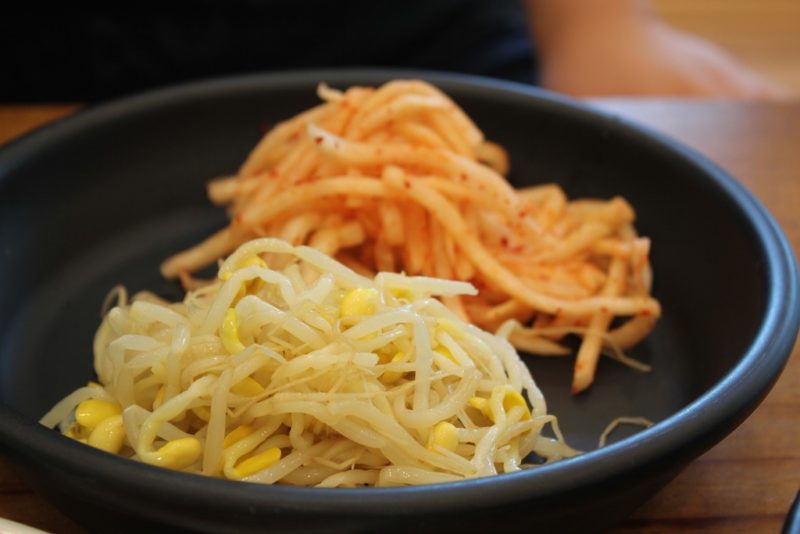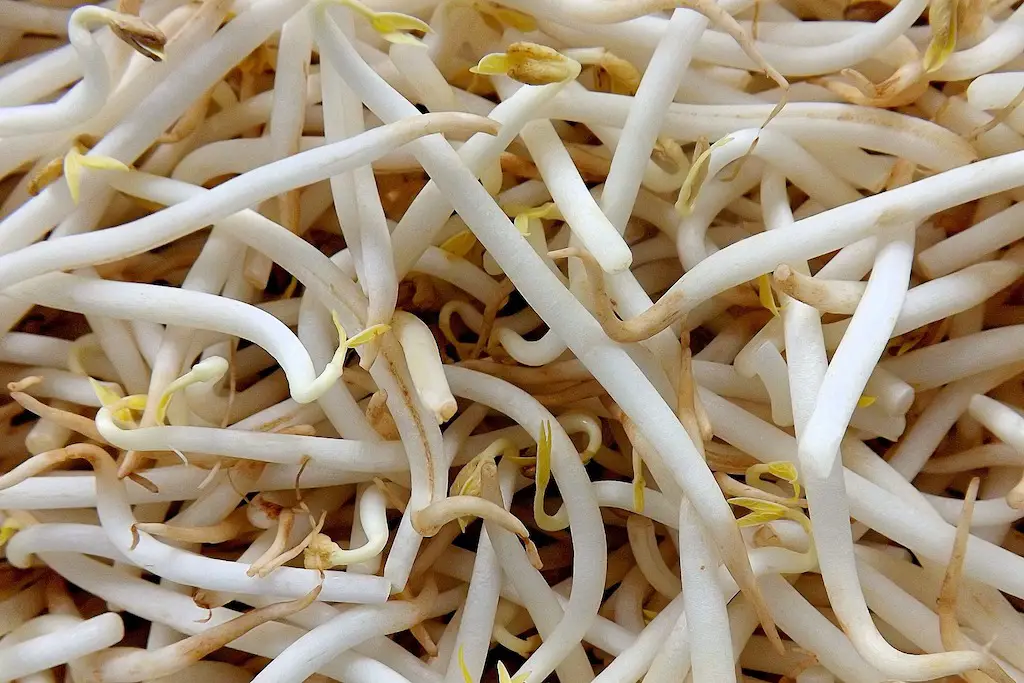This post may contain affiliate links. Please read my disclosure for details at the bottom of this page. As an Amazon Associate, I earn from qualifying purchases on this post about sukju, otherwise known as mung bean sprouts. We hope you enjoy learning about sukju-namul in Korean cooking!
While uncommon in western cooking, different types of bean sprouts have been used by many East Asian cultures in their cultural cooking. Mung bean sprouts are no exception. You can find these sprouts used all across Asia in some of the most culturally influential dishes internationally. For example, think of mung bean sprouts used in the Thai dish pad thai, the Vietnamese dish pho, and the Korean dish bibimbap.
In South Korea, while used less often than soybean sprouts, people use mung beans as a fresh and crunchy ingredient to a multitude of dishes. Here, we will discuss the use of mung bean sprouts in Korean cooking as well as discuss the cultural significance of this ingredient.
Mung Bean Sprouts in Korean Culture:
In the Korean language, the term for mung bean is ‘nokdu’ (녹두). People refer to mung bean sprouts as ‘sukju’ (숙주) or ‘sukju-namul’ (숙주나물). While used interchangeably, the term ‘sukju’ refers solely to the mung bean sprouts while ‘sukju-namul’ can refer to 1) the sprouts themselves or 2) a seasoned salad made from the mung bean sprouts.
The term ‘sukju-namul’ is a compound word made up of ‘sukju’ and ‘namul’ with a very culturally and historically significant story to the Korean peninsula. Below, we give the story of how this ingredient was named during the Joseon period as well as how it is an important piece of Korean history.
The History of the Term Sukju-Namul:
As the story goes, ‘Sukju’ derives from the name Sin Sukju (1417-1475), a prominent Joseon scholar. He famously helped Kim Sejong create the Korean alphabet which is still used today. While alive, King Sejong deeply trusted him. Before King Sejong passed away, he asked his most trusted officials to protect his family line as his eldest son, Munjong, was very weak and his grandson, Danjong, was still incredibly young. As King Sejong expected, his son’s time as king was cut short–King Munjong died at the age of 39 from illness after reigning for only 3 years. His son, King Danjong, was still a child when he was crowned as King at the age of 12.
Infamously, at this time, Sin Sukju betrayed the late King Sejong, his friends, and colleagues by supporting King Danjong’s uncle, Sejo, as a claimant to the throne. Sejo, King Sejong’s younger brother, led a coup, succeeding at taking the throne by ordering King Danjong’s execution in 1455. When Sejo became King, Shin Sukju became his trusted advisor.

Sukju-Namul Next to Korean Radish Salad.
As a result of Sin Sukju’s unethical and immoral behavior, people named mung bean sprouts after him. You may notice that mung bean sprouts tend to go bad within a few days. Because of how quickly and easily they spoil, people living during King Sejo’s reign started to refer to the sprouts as ‘sukju.’ What a legacy for Sin Sukju, right?
The second part of the compound, ‘Namul’ (나물), is a Korean term that either refers to a variety of edible foliage or the seasoned dishes made of them. Examples of this include mung bean sprouts or mung bean sprout salad ‘sukju-namul’ (숙주나물), chrysanthemum greens or chrysanthemum greens salad ‘Ssukgat namul’ (쑥갓나물), and spinach or spinach salad ‘Sigeumchi-namul’ (시금치나물).
Mung Bean Sprouts in Korean Cooking:
In Korean cooking, mung bean sprouts are not as common as soybean sprouts. While not as widely used in Korean cuisine, people use them in particular dishes. Below, we list some examples of mung bean sprouts in Korean cuisine!
- Sukju-Namul (숙주나물): As I stated above, sukju-namul can refer to a mung bean sprout seasoned salad. This is a common banchan (side dish) recipe!
- Bibimbap (비빔밥): Bibimbap is a popular rice dish in and out of Korea. To make the most common version of this dish, you top rice with different types of sauteed and seasoned vegetables, protein, and a gochujang-based sauce. People often add sprouts as a vegetable ingredient in bibimbap.
- Mandu (만두): In English, you translate ‘mandu’ as ‘dumplings.’ Often, people use sprouts as an ingredient in dumpling fillings.
- Bindaetteok (빈대떡): Bindaetteok, or mung bean pancakes, are a type of buchimgae (Korean savory pancake). You make these pancakes by grinding mung beans and frying them with added vegetables and meat. When pan-fried, people form them into a circular, flat shape. While you make the batter using soaked mung beans, people often add sprouts in to add a crunchy texture to the pancake.
Mung Bean Sprouts Season:
Sukju-namul are a type of year-round fresh produce! No need to wait around for the correct season to come!
When choosing mung bean sprouts, look for those that do not have any browning on the stem. The sprouts should be crunchy and crisp rather than soggy. Eat these sprouts quickly because they only stay good for a few days.
Where to Buy Sukju:
Interestingly, while soybean sprouts are more common in South Korea, mung bean sprouts are more common in the United States. Typically, when you buy ‘bean sprouts’ in your average well-stocked grocery store, they are fresh mung bean sprouts.
If mung bean sprouts are not available at your typical grocery store, try looking in your local Asian grocery store. Further, if you do not have an Asian grocery store in your area, you can easily grow sprouts at home! I recommend checking out Maangchi’s explanation if you choose to grow sprouts. Just note, if you choose to grow mung bean or soybean sprouts at home, make sure to research how to do it safely. Both types of sprouts can easily go bad and can carry many different food-borne illnesses. These days, you can even get a bean sprout growing machine!
I Hope You Enjoyed Learning Sukju in Korean Cooking!
In the end, I hope you enjoyed learning about sukju in Korean cooking. If so, let me know in the comment section below. Also, what do you usually make when cooking with mung bean sprouts?
If you would like to read more about cooking, you can find further recipes on this blog. I listed some of my favorite Carving A Journey recipes below! For reference, many recipes are influenced by my family’s blended Korean and Southern heritage.
Korean Ingredient Articles:
- What are Perilla Leaves (Kkaennip)?
- Dangmyeon (Sweet Potato Glass Noodles)
- Gochugaru (Korean Pepper Powder)
- Korean Soy Sauce: What Should I Buy?
- Gluten-Free Gochujang Brands
- Gluten-free Doenjang Brands
Further Carving A Journey Korean Recipes:
- Greek Momo Recipe (Korean Breakfast Trend)
- Tteokkochi (Korean Rice Cake Skewers)
- Jumeokbap (Handmade Korean Rice Balls)
- Bibimmyeon (Korean Spicy Cold Noodles)
If you have any questions or comments, you can also email me at [email protected]. And, finally, I would love to hear from you through our social media as well! You can follow me at @carvingajourney on Instagram, Facebook, and Pinterest. I also started a vlog YouTube channel with my husband! Or, if you would like more articles like these, you can subscribe to the blog by joining the mailing list. I hope you enjoyed learning about mung bean sprouts! Thank you so much for stopping by!
Carving A Journey is a participant in the Amazon Services LLC Associates Program, an affiliate advertising program designed to provide a means for sites to earn advertising fees by advertising and linking to Amazon.com. Although we may earn commissions for our endorsement, recommendation, testimonial, and/or link to any products or services from this website, these opinions are my own and I fully support these products.

